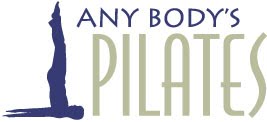When I moved to Charleston, most people didn't know what Pilates was, or had experienced a fusion version of Mat Pilates (Yogilates, PiYo, Body Flow), on a yoga mat, so had no concept of Pilates apparatus. Several have since commented they know now -- based on a equipment informercial on cable TV. Whether you're thinking about adding equipment to your home gym, taking classes at a local studio or learning more about Pilates, do due diligence.
 |
| Long Stretch on Reformer |
If you're thinking about buying apparatus, make sure to understand the purpose and function and that you, or someone who can teach you, are qualified to safely use the equipment. Know the dimensions, weight and how much clearance is needed on all sides, including when in use. If this seems obvious or crazy, search the "for sale" section of
craigslist -- there are dozens of items listed that have never been out of the box or rarely used. Buyers didn't have enough room, didn't know how to use, didn't get a good workout (i.e. didn't know how to use the equipment), or were overwhelmed watching a DVD and figuring out the intricacies of the apparatus. A DVD may be helpful, but probably won't be descriptive enough to walk a new user through the exercises, since watching the screen and doing the exercises at the same time isn't possible.
Make sure the seller is reputable and selling what they claim. This week,
a woman in California was convicted of importing and trafficking counterfeit Bowflex, Beachbody and Maiibu Pilates equipment (all brands featured in infomercials). Her sentence was 90 years in jail and $12 million in fines, so she must have sold a sizable quantity before she was caught.
 |
| Peak Pilates Wunda Chair |
Most importantly, be sure to understand all the safety guidelines and the potential consequences. The simplest pieces of Pilates equipment often appear to be the most benign, when in fact, they are the most difficult and most likely for a newcomer to sustain an injury.
An easier way to get a great workout is to find a local Pilates studio. Not only will the studio offer private, small-group and class sessions utilizing the apparatus that caught the buyer's eye, but several other pieces as well. Different apparatus provide a more well-rounded, balanced and comprehensive workout, as each apparatus has its own purpose and provides particular challenges for the client. Most studios have high-quality, name-brand equipment (
Peak Pilates,
Balanced Body,
Gratz,
Pilates Designs by Basil).
Most studios have high-quality, name brand equipment, but not all. Shortly after I moved to Charleston, I found a studio that paid a local carpenter to make equipment for them. The owner selected a particular wood for the "look," to match the interior design of the studio. Although the equipment looked similar to name brand equipment, within 6 months, the equipment began falling apart mid-session, to the horror of instructors and clients, and at least one client was injured. The same studio had wall-mounted tower units that were installed incorrectly, and pulling away from the wall. Be sure to ask the studio about their equipment and maintenance. Some studios purchase rollaway or portable equipment from reputable manufacturers to reduce equipment costs. There is nothing wrong with this, as long as the equipment is properly used, installed and maintained, but it may not feel as sturdy or be as comfortable as higher-end models.
 |
| Tree on Ladder Barrel |
|
Another advantage to studio equipment is that it's combined with personalized instruction by teachers with hundreds of hours of training and years of experience. With an instructor guiding the client through the exercises, the individual not only learns about the equipment and the exercises, but also receives cues from the instructor to improve his/her form and experience a better workout. Remember, instructors are people, and studios are run by people, so if one doesn't work for you, try another. It's a relationship -- clients need to feel supported, respected, comfortable and safe.
When calling or visiting a studio, ask about their equipment and teacher training, safety guidelines, etc. If you're not satisfied that the studio is knowledgeable and safety-conscious, or that the equipment is high-quality, installed correctly and well-maintained, or the instructors are well-trained and conscientious, keep looking.
Do due diligence. Know what you're paying for and understand how to make the most of it, whether it's home equipment or lessons in a studio.
























